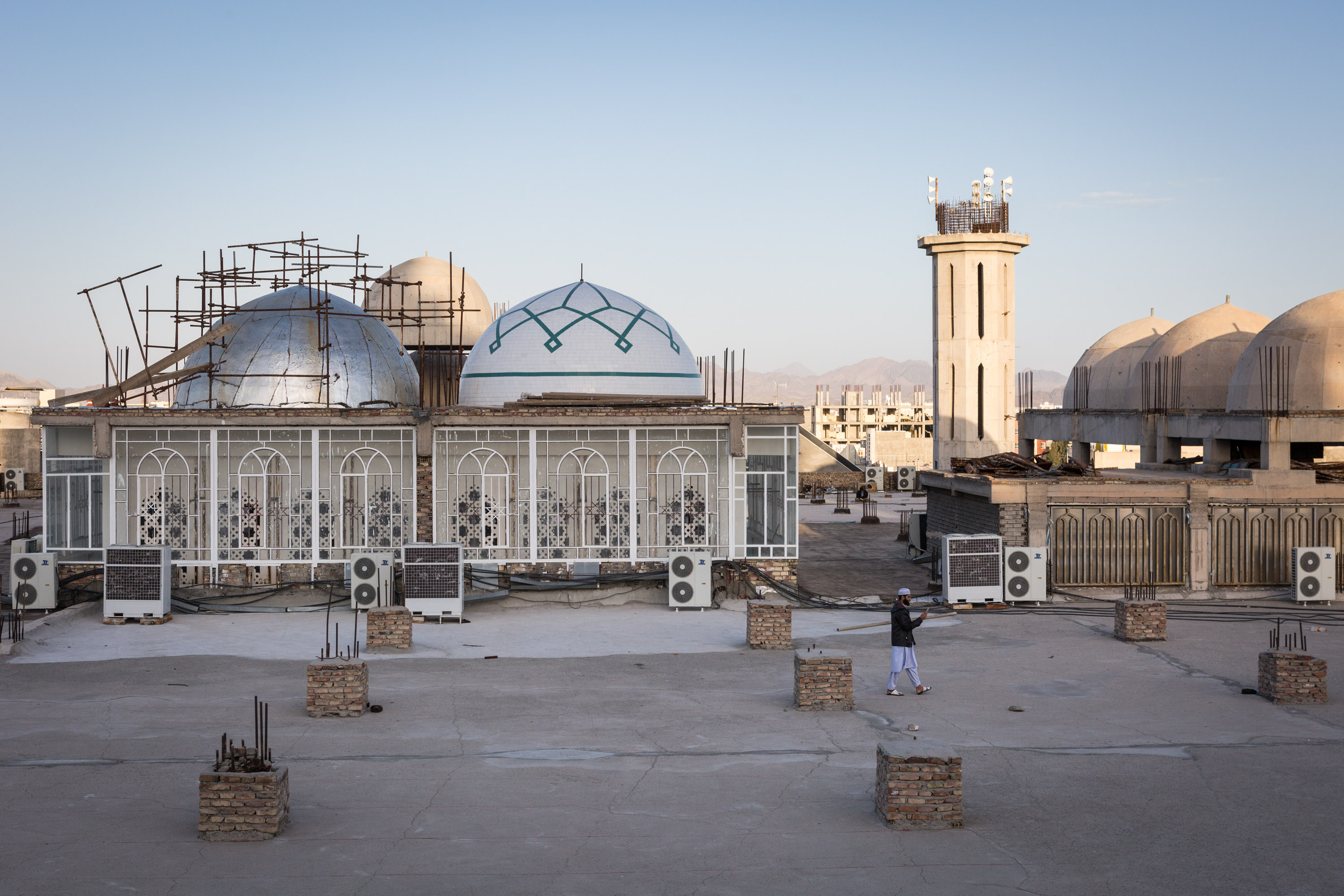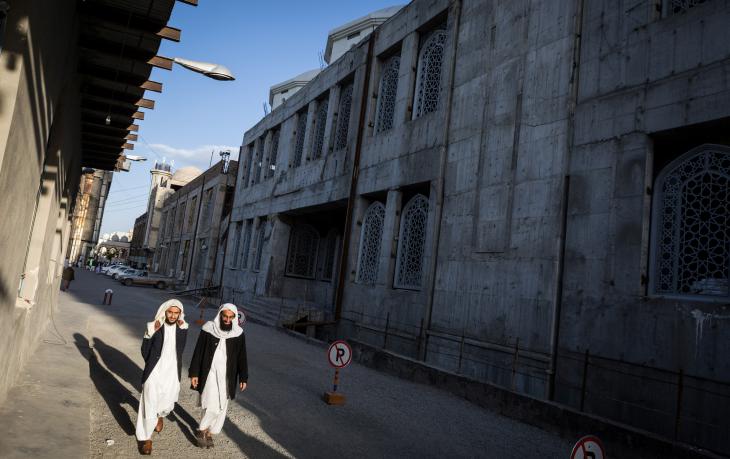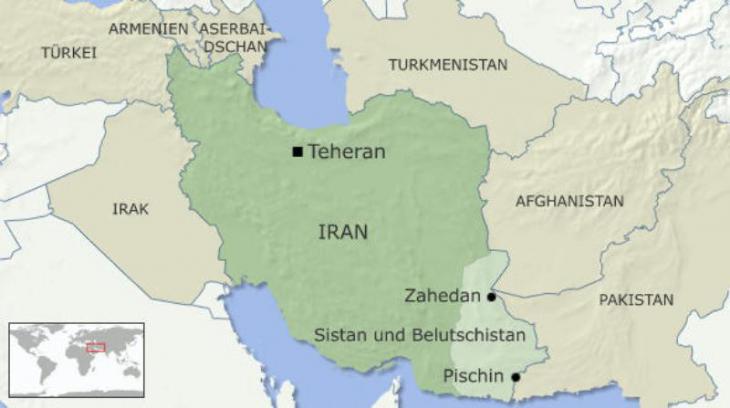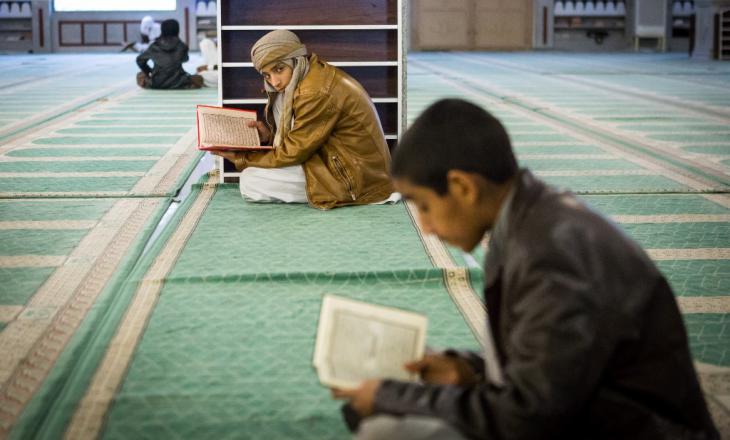The Zahedan network

A cold wind blows through the cement carcass of the Makki Mosque in Zahedan. Pigeons fly through the scaffolding in the interior of the gigantic construction site. Two watchmen warm their hands over a small oil stove. The capital of Sistan and Balochistan Province in Iran is still cold in the early morning before the perennial heat takes over for the day.
Seven years have passed since the old mosque was torn down. It was meant to be replaced with a new, prestigious building, some 50,000 square metres in size, modelled on the Sultan Ahmed Mosque in Istanbul. At the moment, construction has been halted due to a lack of money. Building works continue whenever there is new funding. In the meantime, the faithful pray in the entrance hall, which no longer looks quite so much like a construction site.
"We require an enormous amount of space, especially for Friday prayers. And even when the mosque is finished one day, there still won't be enough space," says Molavi Abdolhamid Ismaeelzahi. The 70-year-old is the administrator of the Makki Mosque and the spiritual leader of Sunni Muslims in Iran. The Makki Mosque is managed by the Jamiah Darul Uloom Islamic University in Zahedan. As the mosque is dependent on donations from within Iran and from abroad, construction has taken much longer than initially anticipated.
A magnet for refugees
Zahedan is one of the few cities in Iran with a majority Sunni population. Over 80 million people live in Iran and the vast majority are Shia Muslims. According to independent estimates, Sunnis make up between five and nine percent of the total population. Some 600,000 live in Zahedan, the majority of whom are ethnic Balochs. There is also a strong Afghan presence comprising those who have fled the war in their home country.

The city is actually closer to Kabul than to the Iranian capital Tehran. The majority of the Zahedan's Baloch population, as well as the refugees, are Sunnis, most adhering to the Hanafi school of Islamic jurisprudence. Many of them belong to the Deobandi movement, which traces its origin to a theological university in India and which has also served as an inspiration for the Taliban.
The campus of Jamiah Darul Uloom in Zahedan, which is located right next to the Makki Mosque, offers study programmes lasting up to 16 years. Its over 1200 students immediately stand out with their traditional attire and large, cropped beards.
The student body is predominantly Iranian, but also includes a number of Afghans and Pakistanis. Students can calmly pursue their studies here, unhampered by the Iranian authorities. The construction plans for the new mosque, however, met with stiff criticism. Plans for the building envisage six minarets, yet the two anterior minarets were deemed by authorities as being far too tall. The building contractors feel that the Iranian state does not want the mosque to be the "showpiece of Sunni architecture that it could have been." The reaction of the authorities in Zahedan was pragmatic: the minarets will now only be half as high as originally planned.
Relative freedom for Zahedan's Sunni community
Hafiz Khodabachsh works in a store for religious literature and articles right next to the mosque. The old man stands between Persian language Islamic literature and miswak sticks, which are used by particularly pious Muslims and many of the university students to clean their teeth. While dusting one bottle of perfume after another, he comments that life for Sunnis in this part of Iran is actually quite good. "We are allowed to practise our religion freely here and we are among ourselves. Only on high Shia holy days, such as Ashura, are there occasionally conflicts."

Khodabachsh has no doubt, however, that Sunnis have it much better in Zahedan than in Tehran. Just a few streets away stands the next large mosque. Here, elegant chandeliers shine from the ceiling and the carpet still glows a resplendent red. The Shia Friday Mosque was recently completely renovated. This was necessary following a terrorist attack committed by Sunni terrorists in July 2010.
A man scrubs the courtyard in front of the entrance. Behind him is a glass display case with the portraits of the 27 people who were killed when two attackers consecutively blew themselves up as the faithful were celebrating the birthday of Imam Hussein. "It all happened so quickly. And when we realised what had happened, it was already too late," recalled an elderly gentleman, who has been coming here for years to pray. The terrorists belonged to an extremist group named "Jondullah" (Soldiers of God) that operates out of Pakistan. Iranians regard the victims of the attack as martyrs.
Jondullah fighters had previously carried out attacks in Zahedan in 2007 and 2009. Their victims are buried in the cemetery in the north of the city. Beyond the hundreds of graves ornamented with Iranian flags – graves belonging to the martyrs of the Iraq-Iran war – one finds somewhat hidden away the graves of the victims of Jondullah. The gravestones state that they were killed by "armed criminal gangs."
Security measures against extremists and separatists
Since 2010, the group has not perpetrated any more attacks on Iranian soil. Armed police not only protect every large Shia mosque in the city around the clock, but also municipal facilities such as the town hall and the train station. There is now a police unit in every train that travels to Zahedan.

Even before the terrorist attacks, the government had enacted a law aimed at avoiding interdenominational conflicts. This banned the construction of Sunni places of worship in urban areas predominantly populated by Shia and vice versa. As a result, Sunnis in cities like Tehran, which are almost exclusively Shia, cannot attend an official Sunni mosque. Or they must search for underground alternatives. Sunni Internet portals refer to nine Sunni mosques in Tehran. All of them are back courtyard mosques without any signs or outward indication as to their true nature. "This is why we don't feel at ease there," said Hafiz Khodabachsh, the storekeeper for religious articles next to the Makki Mosque.
Even though the government maintains a monopoly on the use of force, life in Zahedan is not free of denominational conflicts and rumours. Some Iranians who have moved to Zahedan claim that the Makki Mosque is being used as a network by Sunni terrorist groups from the region, such as the Taliban from Afghanistan, al-Qaida, the Islamic Movement of Uzbekistan, the Pakistani Jondullah and the Islamic Jihad Union, to which the four members of the German Sauerland Group belonged. They were welcomed in Zahedan before travelling on to Pakistan for training.
The geographical location of Zahedan certainly offers Sunni groups in the tri-border region of Iran, Afghanistan and Pakistan an ideal place for interaction. Molavi Abdolhamid Ismaeelzahi, the spiritual head of Iranian Sunnis, has been characterised by many in the Iranian media as a "moderate Sunni voice." Yet, even he depends on Sunnis from neighbouring countries to come to his city to build networks. In July 2014, the Iranian government imposed a travel ban on Ismaeelzahi.
Philipp Breu
© Qantara.de 2017
Translated from the German by John Bergeron
